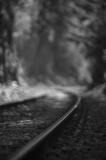
| Home | Open Account | Help | 350 users online |
|
Member Login
Discussion
Media SharingHostingLibrarySite Info |
Railfan Technology > Good Fun with Bad LensesDate: 03/12/14 17:26 Good Fun with Bad Lenses Author: loleta I recently came across some interesting photos taken with a Russian Helios lens. After a little research I discovered a whole fringe subculture in photography: adapting old manual-focus, usually screw-mount, lenses for use on modern digital bodies. Some of these folks are hardcore: filing down the mirrors on their DSLRs to make the lenses clear the mirror, for instance. I’m going to resist getting too far into this eccentricity myself, but I have purchased two different versions of the 58mm Helios 44 (an old chrome 44-2 and a newer 44M with multi-coating but fewer aperture blades), an Industar 50 mm pancake lens, and the poor man’s Helios 40-2: the Cyclop H3T-1 f1.5 fixed-aperture 85mm. A Helios 44 in good condition is less than $100, the Cyclop is a couple of hundred, and the Industar in perfect condition was $35. Many of these Russian lenses, like the Helios 44 (possibly the world’s most mass-produced lens), are copies of Zeiss lenses, but obviously you’re nuts if you think you’re getting a Zeiss-quality lens for under $100. In fact, the appeal of the Helios and the Cyclop is their poor optical quality, specifically their technically terrible bokeh. The unique swirling effect of the out-of-focus features is what makes a good copy of a Helios 40-2 $400 and up: portrait photographers and the mirrorless crowd are snapping them up (although bokeh purists hate them). The less expensive Cyclop, actually the front lens of a Russian night-vision scope, is the same as the 40-2 but has a fixed aperture of f1.5; not a problem, really, since wide-open is where these lenses are interesting. Really, there’s no good reason to make any of these your everyday lens -- except perhaps to show off the cool Cyrillic lens caps or, with the Cyclop, to make people wonder, What the hell is that? Anyway, if you like optical oddities and the feel of heavy, manual-focus lenses -- the Cyclop looks and feels like it was machined from a solid block of lead – pick up a Helios, Industar, Cyclop, Jupiter (15 aperture blades!), or Tair.
Some samples: 1. The older Helios 44-2 does okay with this dull, low-contrast scene of CN train 546 at Horseshoe Bay, BC... 2. ... and quite well indeed in this sunny morning shot of 546 in West Vancouver, though I had to correct some vignetting in PS. Even so, there's no reason for me not to use a modern lens for these shots. 3. Here's why you want to use the Helios lenses: the out-of-focus elements have a weird cubist look here... (continued) Loleta Fernbridge Edited 2 time(s). Last edit at 03/13/14 19:08 by loleta.    Date: 03/12/14 17:29 Re: Good Fun with Bad Lenses Author: loleta 4. Horsheshoe Bay on acid.
5. The background becomes completely abstracted. 6. black-and-white swirl. - L.F.    Date: 03/12/14 18:46 Re: Good Fun with Bad Lenses Author: Train611 Interesting images...
611 Date: 03/13/14 12:47 Re: Good Fun with Bad Lenses Author: robj Thanks! Good examples. I guess there are various "subcultures" of these types. At the end of the day it all about enjoying what you do.
Bob Date: 03/13/14 17:22 Re: Good Fun with Bad Lenses Author: trainfreek what an absolutely fascinating post...thanks so much for sharing. the pics are brilliant!
Mark Wohlgemuth Culpeper, VA Date: 03/13/14 18:56 Re: Good Fun with Bad Lenses Author: jonjonjonjon Going through old slides recently, I almost tossed this one - shot with a cheap telephoto lens - but I kinda like it now. I don't know the brand of the lens, but I almost wish I had it now since it would actually work with my present camera.
On the D&H just out of Binghamton - shot in 1978.  Date: 03/13/14 19:24 Re: Good Fun with Bad Lenses Author: loleta Someone asked me where I bought the lenses:
All lenses purchased on Ebay, the M42 to Canon EOS adaptors from B&H Photo. Caveat emptor buying these lenses: most come from Russia or Ukraine, are often described as being in better condition than they actually are, and the presence of flaws is usually indicated by omission. So for example, if the ad says "glass clean, clear, no scratches, no oil on the blades, no fungus" the lens is probably okay. But if it reads "glass clean, clear, no oil on the blades, no fungus" then there are likely scratches. Similarly, no mention of oil on the blades likely indicates oil on the blades. And so on. Sellers probably count on the unlikelihood of anyone actually returning a $50 lens to Belarus. Oh, and the rear element on some M42-mount lenses will interfere with the mirror when focused to infinity, so do a little internet research to check for compatibility. That being said, it's a lot of fun to get these things in the mail and try them out. - L. F. Edited 1 time(s). Last edit at 03/13/14 21:24 by loleta. Date: 03/14/14 18:30 Re: Good Fun with Bad Lenses Author: GenePoon Buying lenses and equipment from the Eastern Bloc can be an adventure! I learned
this when acquiring medium format Kiev SLRs and associated lenses and accessorties. There are some reliable sellers (those who have more than dabbled in this field know who they are; some found it necessary to rework brand-new equipment right out of the factory) but their wares are far more expensive, and sometimes you just HAVE to take a chance on something really cheap when the chance turns up! |